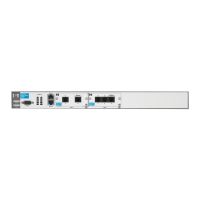B-36
Appendix B: Glossary
NT1 Network Termination 1. A device at the physical and electrical termination of
the ISDN line. The NT1 monitors the line, maintains timing, and provides
power to the ISDN line. This device is purchased and maintained by the
subscriber.
NT12 Network Termination 1 2. A device that functions as both an NT1 and an NT2
device.
NT2 Network Termination 2. A device required for PRI ISDN. The NT2 provides
switching functions and manages traffic across the multiple B channels.
NVRAM Non-Volatile Random Access Memory. A data-storage medium that retains
memory when powered down.
O
OAM Operations, Administration, and Maintenance. OAM ATM cells are sent over
a VCI to maintain the link. OAM cells are divided into five levels, and the
functions of each level are separate from those of each other level. See also
F5 OAM.
OC-1 Optical Carrier-1. In the Synchronous Digital Hierarchy, OC-1 is the base
multiple for SONET systems and transmits as 51.84 Mbps.
OC-N Optical Carrier Level N. The fundamental transmission rates for SONET,
where N=1 (51.84 Mbps), 3 (155.52 Mbps), 12 (622 Mbps), 24 (1.244 Gbps), 48
(2.488 Gbps) or 192 (9.953 Gbps).
OCU Office Channel Unit. A Central Office (CO) device that is used for direct
handling of 56K and 64K DDS services. The OCU is usually a special card
incorporated into multiplexers at the CO.
OCUDP Office Channel Unit Data Port. A CO device that provides signal conversion
from the transmission rates on the customer side of the local loop to a single
DS0 time slot. It provides the interface between Switched 56/64K or DDS
interfaces and the telecom infrastructure.
Option Parameters or variables supported by a protocol. For example, the PPP LCP
protocol includes options for whether or not peers will use LQR, magic
numbers, protocol-field compression, address and control field compression,
or an authentication protocol. The MRU option specifies the maximum size
for packets sent over the connection.

